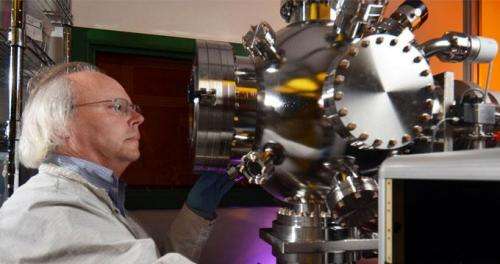JILA's instrument shop features innovation and precision

In the late 1980s, scientists in a JILA lab on the CU-Boulder campus were trying to create a new form of matter at what would be the coldest temperature in the universe. To reach such an unimaginable temperature, where atoms become sluggish and begin behaving oddly, researchers needed special equipment in order to trap and slow them down to study.
All in a day’s work for JILA, joint institute of CU-Boulder and the National Institute of Standards and Technology. The goal to produce a temperature a few hundred billionths of a degree above absolute zero required the construction of a one-of-a-kind apparatus in JILA’s instrument shop and optics lab. The shop fabricated the device, and the result was a 2001 Nobel Prize in physics for JILA Fellows Eric Cornell and Carl Wieman.
Renowned for their ability to design and build precision equipment for a vast array of experiments, JILA’s instrument shop and Keck Optical Measurement Laboratory play a key role in assisting researchers with their pioneering work.
"The JILA shops -- instrument, electronics, clean room, Keck laboratory --are of a quality I've never encountered in any other academic department with which I'm familiar,” said Eric Cornell, chair of JILA. “The fact that our shops have been so consistently excellent, year in and year out, represents a major competitive advantage for JILA vis-a-vis other physics and chemistry departments around the country and around the world. The interaction between the scientists and the instrument makers is at a very high level. Truly the instrument makers are important collaborators in the overall research at JILA."
Cooperation between scientists and instrument-makers makes it possible for shop staff to apply their world-class expertise in designing and fabricating state-of-the-art, custom experimental apparatuses. This collaborative strategy results in the fabrication of just about any seemingly improbable thing scientists need for their research, according to Todd Asnicar, manager of the instrument shop who has been with JILA for 11 years.
“JILA has a long history of supporting its shops that continues today,” said Asnicar. “We can do what we do because of that support and, of course, the vision of the researchers. Each one of us in the shop brought his own strengths and skills to the job, but what we do here is something that you can really only learn by working here. We are all to a great extent products of JILA and because of that, we feel that we are at least a small part of the amazing things that happen here and take a great deal of pride in that.”
Craftsmen in JILA's instrument shop design and build a wide range of experimental devices and offer training courses in the use of shop equipment for faculty and students.
“We build things the researchers can’t buy,” said instrument maker Blaine Horner. “And we modify and the things they can buy. Our role is to understand what the researchers are doing at least enough to help them accomplish their goal as best we can.”
The Keck Optical Measurement Laboratory, a research and educational facility funded by the Keck Foundation, provides optical-measurement and optical-characterization instruments, including lasers and a variety of instruments used in metrology, imaging, microfabrication, and nanofabrication. A new 1,500-square-foot “clean room” enables materials to be manufactured without dust or other contaminants. Clean room projects include single electron devices, nanoposts for DNA studies, on-chip power cells, and microfluidic devices.
In 2005, JILA Fellow Jan Hall received a Nobel Prize in physics for his breakthrough work on laser-based precision measurement techniques. Instrument makers fabricated a special mirror mount that positioned the laser that enabled Hall to accurately measure the color of the light of atoms and molecules. JILA became known for its high quality mirror mount instruments that were in such demand among scientists at other institutions that they were produced in the instrument shop and sold for a time.
“Our mirror mounts were the envy of the photonics world,” said optical lab manager David Alchenberger, who has been with JILA since 1992.
The instrument shop and optics lab occasionally take in work from departments outside of JILA. Alchenberger provided the final and critical polishing of a six-inch wide, metal concave dust detector designed by the Laboratory for Atmospheric and Space Physics, which will be launched in 2013 on a NASA lunar probe to study the moon’s dust. As a thank you to Alchenberger for his skilled work on the dust detector, his name (along with others) was engraved on an instrument panel onboard the NASA probe.
JILA researchers often honor the instrument shop fabricators by acknowledging them in scientific papers. Sometimes, though, acknowledgment takes a more creative turn. Countertops throughout the recently opened new wing of the JILA building are made from recycled metal shavings from the shop.
There are six staff members, including an apprentice, as well as a handful of student assistants who work in the instrument shop and optical lab. The instrument shop contains metal lathes, two complete rooms full of cutting, measuring, and shaping tools for a variety of materials, drawers full of arcane fittings, screws, attachments, flanges, joints, connectors, rare metal and ceramic paraphernalia, grinders, sanders, Bunsen burners, welding torches, a kiln, laser lenses, electronic components, and electron microscopes. Computers are loaded with cutting-edge rendering software.
Instrument shops like JILA’s, and people with the expertise and creativity to staff them, are becoming rare, according to Alchenberger, who says many institutions and universities are outsourcing the fabrication of apparatuses and instruments to
commercial job shops. JILA’s shop staff prides themselves on their extensive experience and ingenious approaches to meeting the needs of a wide range of experimental projects.
“The work we do here is innovative,” said Alchenberger. “You get these wonderful moments of incredible gratification that you’re doing something significant.
“Plus,” he added with a laugh, “my name will be on the moon forever.”
Provided by University of Colorado at Boulder




















